Anti-Reflective Coatings Produced via Atomic Layer Deposition for Hybrid Polymer 3D Micro-Optics
Abstract
:1. Introduction
2. Materials and Methods
2.1. Preparation of Spin-Coated Samples
2.2. Fabrication of 3D Microstructures
2.3. Deposition of Thin Films
2.4. Characterization Methods
3. Results and Discussion
3.1. Growth Dynamics of Aluminum Oxide on SZ2080™
3.2. Spin-Coated and Thermally Polymerized SZ2080™ Film Optical Characteristics
3.3. Single-Layer Coatings
3.4. Anti-Reflective Coating
4. Conclusions
Author Contributions
Funding
Data Availability Statement
Acknowledgments
Conflicts of Interest
References
- Raut, H.K.; Ganesh, V.A.; Nair, A.S.; Ramakrishna, S. Anti-Reflective Coatings: A Critical, in-Depth Review. Energy Environ. Sci. 2011, 4, 3779. [Google Scholar] [CrossRef]
- Wang, Z.; Wang, Y.; He, H.; Shen, Z.; Sytchkova, A.; Chen, R.; Zhang, Y.; Li, D.; Hu, G.; Zheng, Y.; et al. Laser-Induced Damage of 1064 Nm Multilayer Antireflection Coatings after Exposure to Gamma Rays. Opt. Mater. 2021, 122, 111580. [Google Scholar] [CrossRef]
- Abromavičius, G.; Buzelis, R.; Drazdys, R.; Juškevičius, K.; Kičas, S.; Tolenis, T.; Mirauskas, J.; Ščiuka, M.; Sirutkaitis, V.; Melninkaitis, A. Optical Resistance and Spectral Properties of Anti-Reflective Coatings Deposited on LBO Crystals by Ion Beam Sputtering. Lith. J. Phys. 2011, 51, 303–308. [Google Scholar] [CrossRef] [Green Version]
- Xi, J.-Q.; Schubert, M.F.; Kim, J.K.; Schubert, E.F.; Chen, M.; Lin, S.-Y.; Liu, W.; Smart, J.A. Optical Thin-Film Materials with Low Refractive Index for Broadband Elimination of Fresnel Reflection. Nat. Photon 2007, 1, 176–179. [Google Scholar] [CrossRef]
- Pfeiffer, K.; Ghazaryan, L.; Schulz, U.; Szeghalmi, A. Wide-Angle Broadband Antireflection Coatings Prepared by Atomic Layer Deposition. ACS Appl. Mater. Interfaces 2019, 11, 21887–21894. [Google Scholar] [CrossRef]
- Tolenis, T.; Grinevičiūtė, L.; Buzelis, R.; Smalakys, L.; Pupka, E.; Melnikas, S.; Selskis, A.; Drazdys, R.; Melninkaitis, A. Sculptured Anti-Reflection Coatings for High Power Lasers. Opt. Mater. Express 2017, 7, 1249. [Google Scholar] [CrossRef]
- Vlček, J.; Belosludtsev, A.; Rezek, J.; Houška, J.; Čapek, J.; Čerstvý, R.; Haviar, S. High-Rate Reactive High-Power Impulse Magnetron Sputtering of Hard and Optically Transparent HfO 2 Films. Surf. Coat. Technol. 2016, 290, 58–64. [Google Scholar] [CrossRef]
- Ristau, D.; Gross, T. Ion Beam Sputter Coatings for Laser Technology. In Proceedings of the Optical Systems Design, Jena, Germany, 30 September 2005; p. 596313. [Google Scholar] [CrossRef]
- Grineviciute, L.; Nikitina, J.; Babayigit, C.; Staliunas, K. Fano-like Resonances in Nanostructured Thin Films for Spatial Filtering. Appl. Phys. Lett. 2021, 118, 131114. [Google Scholar] [CrossRef]
- Grineviciute, L.; Babayigit, C.; Gailevičius, D.; Peckus, M.; Turduev, M.; Tolenis, T.; Vengris, M.; Kurt, H.; Staliunas, K. Nanostructured Multilayer Coatings for Spatial Filtering. Adv. Opt. Mater. 2021, 9, 2001730. [Google Scholar] [CrossRef]
- Siegle, L.; Ristok, S.; Giessen, H. Complex Aspherical Singlet and Doublet Microoptics by Grayscale 3D Printing. Opt. Express 2023, 31, 4179. [Google Scholar] [CrossRef]
- Gonzalez-Hernandez, D.; Varapnickas, S.; Bertoncini, A.; Liberale, C.; Malinauskas, M. Micro-Optics 3D Printed via Multi-Photon Laser Lithography. Adv. Opt. Mater. 2023, 11, 2201701. [Google Scholar] [CrossRef]
- Varapnickas, S.; Chandran Thodika, S.; Moroté, F.; Juodkazis, S.; Malinauskas, M.; Brasselet, E. Birefringent Optical Retarders from Laser 3D-Printed Dielectric Metasurfaces. Appl. Phys. Lett. 2021, 118, 151104. [Google Scholar] [CrossRef]
- Grinevičiūtė, L. Nanostructured Optical Coatings for the Manipulation of Laser Radiation. Ph.D. Thesis, Vilnius University, Vilnius, Lithuania, 2021. [Google Scholar]
- Pfeiffer, K.; Schulz, U.; Tünnermann, A.; Szeghalmi, A. Antireflection Coatings for Strongly Curved Glass Lenses by Atomic Layer Deposition. Coatings 2017, 7, 118. [Google Scholar] [CrossRef] [Green Version]
- Paul, P.; Pfeiffer, K.; Szeghalmi, A. Antireflection Coating on PMMA Substrates by Atomic Layer Deposition. Coatings 2020, 10, 64. [Google Scholar] [CrossRef] [Green Version]
- Ristok, S.; Flad, P.; Giessen, H. Atomic Layer Deposition of Conformal Anti-Reflective Coatings on Complex 3D Printed Micro-Optical Systems. Opt. Mater. Express 2022, 12, 2063. [Google Scholar] [CrossRef]
- Arriaga Dávila, J.; Winczewski, J.P.; Herrera-Zaldívar, M.; Murillo-Bracamontes, E.A.; Rosero Arias, C.; Pineda-Aguilar, N.; Cholula-Díaz, J.L.; De Leon, I.; Gardeniers, H.; Susarrey Arce, A.; et al. Enabling High-Quality Transparent Conductive Oxide on 3D Printed ZrO2 Architectures through Atomic Layer Deposition. Appl. Surf. Sci. 2023, 636, 157796. [Google Scholar] [CrossRef]
- George, S.M. Atomic Layer Deposition: An Overview. Chem. Rev. 2010, 110, 111–131. [Google Scholar] [CrossRef]
- Merkininkaitė, G.; Aleksandravičius, E.; Malinauskas, M.; Gailevičius, D.; Šakirzanovas, S. Laser Additive Manufacturing of Si/ZrO2 Tunable Crystalline Phase 3D Nanostructures. Opto-Electron. Adv. 2022, 5, 210077. [Google Scholar] [CrossRef]
- Gailevicius, D.; Zvirblis, R.; Galvanauskas, K.; Bataviciute, G.; Malinauskas, M. Calcination-Enhanced Laser-Induced Damage Threshold of 3D Micro-Optics Made with Laser Multi-Photon Lithography. Photonics 2023, 10, 597. [Google Scholar] [CrossRef]
- Ovsianikov, A.; Viertl, J.; Chichkov, B.; Oubaha, M.; MacCraith, B.; Sakellari, I.; Giakoumaki, A.; Gray, D.; Vamvakaki, M.; Farsari, M.; et al. Ultra-Low Shrinkage Hybrid Photosensitive Material for Two-Photon Polymerization Microfabrication. ACS Nano 2008, 2, 2257–2262. [Google Scholar] [CrossRef]
- Gonzalez-Hernandez, D.; Sanchez-Padilla, B.; Gailevičius, D.; Thodika, S.C.; Juodkazis, S.; Brasselet, E.; Malinauskas, M. Single-step 3D printing of micro-optics with adjustable refractive index by ultrafast laser nanolithography. Adv. Opt. Mater. 2023, 11, 2300258. [Google Scholar] [CrossRef]
- The OptiLayer Thin Film Software. Available online: https://optilayer.com/ (accessed on 8 July 2023).
- Dudziak, M.; Topolniak, I.; Silbernagl, D.; Altmann, K.; Sturm, H. Long-Time Behavior of Surface Properties of Microstructures Fabricated by Multiphoton Lithography. Nanomaterials 2021, 11, 3285. [Google Scholar] [CrossRef] [PubMed]
- Bauer, J.; Izard, A.G.; Zhang, Y.; Baldacchini, T.; Valdevit, L. Thermal Post-Curing as an Efficient Strategy to Eliminate Process Parameter Sensitivity in the Mechanical Properties of Two-Photon Polymerized Materials. Opt. Express 2020, 28, 20362. [Google Scholar] [CrossRef]
- Lingnau, J.; Meyerhoff, G. The Spontaneous Polymerization of Methyl Methacrylate: 6. Polymerization in Solution: Participation of Transfer Agents in the Initiation Reaction. Polymer 1983, 24, 1473–1478. [Google Scholar] [CrossRef]
- Femtika Ltd. Available online: https://femtika.com/ (accessed on 8 July 2023).
- Jonušauskas, L.; Gailevičius, D.; Rekštytė, S.; Baldacchini, T.; Juodkazis, S.; Malinauskas, M. Mesoscale Laser 3D Printing. Opt. Express 2019, 27, 15205. [Google Scholar] [CrossRef] [PubMed] [Green Version]
- OpenSCAD software. Available online: https://openscad.org/ (accessed on 8 July 2023).
- Skliutas, E.; Samsonas, D.; Čiburys, A.; Kontenis, L.; Gailevicius, D.; Narbutis, D.; Jukna, V.; Vengris, M.; Juodkazis, S.; Malinauskas, M. X-Photon Laser Direct Write 3D Nanolithography. Virtual Phys. Prototyp. 2023, 18, 1. [Google Scholar] [CrossRef]
- Knapas, K.; Ritala, M. In Situ Studies on Reaction Mechanisms in Atomic Layer Deposition. Crit. Rev. Solid State Mater. Sci. 2013, 38, 167–202. [Google Scholar] [CrossRef]
- Janssen, G.C.A.M.; Abdalla, M.M.; Van Keulen, F.; Pujada, B.R.; Van Venrooy, B. Celebrating the 100th Anniversary of the Stoney Equation for Film Stress: Developments from Polycrystalline Steel Strips to Single Crystal Silicon Wafers. Thin Solid Film. 2009, 517, 1858–1867. [Google Scholar] [CrossRef]
- Kwon, S.-H.; Kwon, O.-K.; Kim, J.-H.; Oh, H.-R.; Kim, K.-H.; Kang, S.-W. Initial Stages of Ruthenium Film Growth in Plasma-Enhanced Atomic Layer Deposition. J. Electrochem. Soc. 2008, 155, H296. [Google Scholar] [CrossRef]
- Wilson, C.A.; Grubbs, R.K.; George, S.M. Nucleation and Growth during Al2O3 Atomic Layer Deposition on Polymers. Chem. Mater. 2005, 17, 5625–5634. [Google Scholar] [CrossRef]
- Spagnola, J.C.; Gong, B.; Arvidson, S.A.; Jur, J.S.; Khan, S.A.; Parsons, G.N. Surface and Sub-Surface Reactions during Low Temperature Aluminium Oxide Atomic Layer Deposition on Fiber-Forming Polymers. J. Mater. Chem. 2010, 20, 4213. [Google Scholar] [CrossRef]
- Jur, J.S.; Spagnola, J.C.; Lee, K.; Gong, B.; Peng, Q.; Parsons, G.N. Temperature-Dependent Subsurface Growth during Atomic Layer Deposition on Polypropylene and Cellulose Fibers. Langmuir 2010, 26, 8239–8244. [Google Scholar] [CrossRef] [PubMed]
- Puurunen, R.L.; Vandervorst, W. Island Growth as a Growth Mode in Atomic Layer Deposition: A Phenomenological Model. J. Appl. Phys. 2004, 96, 7686–7695. [Google Scholar] [CrossRef]
- Guo, H.C.; Ye, E.; Li, Z.; Han, M.-Y.; Loh, X.J. Recent Progress of Atomic Layer Deposition on Polymeric Materials. Mater. Sci. Eng. C 2017, 70, 1182–1191. [Google Scholar] [CrossRef]
- Žukauskas, A.; Batavičiūtė, G.; Ščiuka, M.; Balevičius, Z.; Melninkaitis, A.; Malinauskas, M. Effect of the Photoinitiator Presence and Exposure Conditions on Laser-Induced Damage Threshold of ORMOSIL (SZ2080). Opt. Mater. 2015, 39, 224–231. [Google Scholar] [CrossRef]
- Paul, P.; Beladiya, V.; Kästner, D.; Schulz, U.; Burkhardt, M.; Szeghalmi, A.V. Conformal Antireflection Coating on Polycarbonate Domes. In Proceedings of the Advances in Optical Thin Films VII, Online, Spain, 12 September 2021; Lequime, M., Ristau, D., Eds.; SPIE: Xiamen, China, 2021; p. 11. [Google Scholar] [CrossRef]
- Krautheim, G.; Hecht, T.; Jakschik, S.; Schröder, U.; Zahn, W. Mechanical Stress in ALD-Al2O3 Films. Appl. Surf. Sci. 2005, 252, 200–204. [Google Scholar] [CrossRef]
- Liu, H.; Jensen, L.; Ma, P.; Ristau, D. Stress Compensated Anti-Reflection Coating for High Power Laser Deposited with IBS SiO2 and ALD Al2O3. Appl. Surf. Sci. 2019, 476, 521–527. [Google Scholar] [CrossRef]
- TFCalc Design Software for Optical Thin Films. Available online: https://www.hulinks.co.jp/en (accessed on 8 July 2023).
- Lau, W.S.; Zhang, J.; Wan, X.; Luo, J.K.; Xu, Y.; Wong, H. Surface Smoothing Effect of an Amorphous Thin Film Deposited by Atomic Layer Deposition on a Surface with Nano-Sized Roughness. AIP Adv. 2014, 4, 027120. [Google Scholar] [CrossRef]
- Elam, J.W.; Sechrist, Z.A.; George, S.M. ZnOyAl2O3 Nanolaminates Fabricated by Atomic Layer Deposition: Growth and Surface Roughness Measurements. Thin Solid Film. 2002, 414, 43–55. [Google Scholar] [CrossRef]
- Myers, T.J.; Throckmorton, J.A.; Borrelli, R.A.; O’Sullivan, M.; Hatwar, T.; George, S.M. Smoothing Surface Roughness Using Al2O3 Atomic Layer Deposition. Appl. Surf. Sci. 2021, 569, 150878. [Google Scholar] [CrossRef]
- Fang, M.; Li, J.; He, H.; Fan, Z.; Xiao, Q.; Li, Z. Evolution and Control of Optical Thin Film Stress; Yang, L., Ruch, E., Li, S., Eds.; SPIE: Xiamen, China, 2012; p. 84160K. [Google Scholar] [CrossRef]
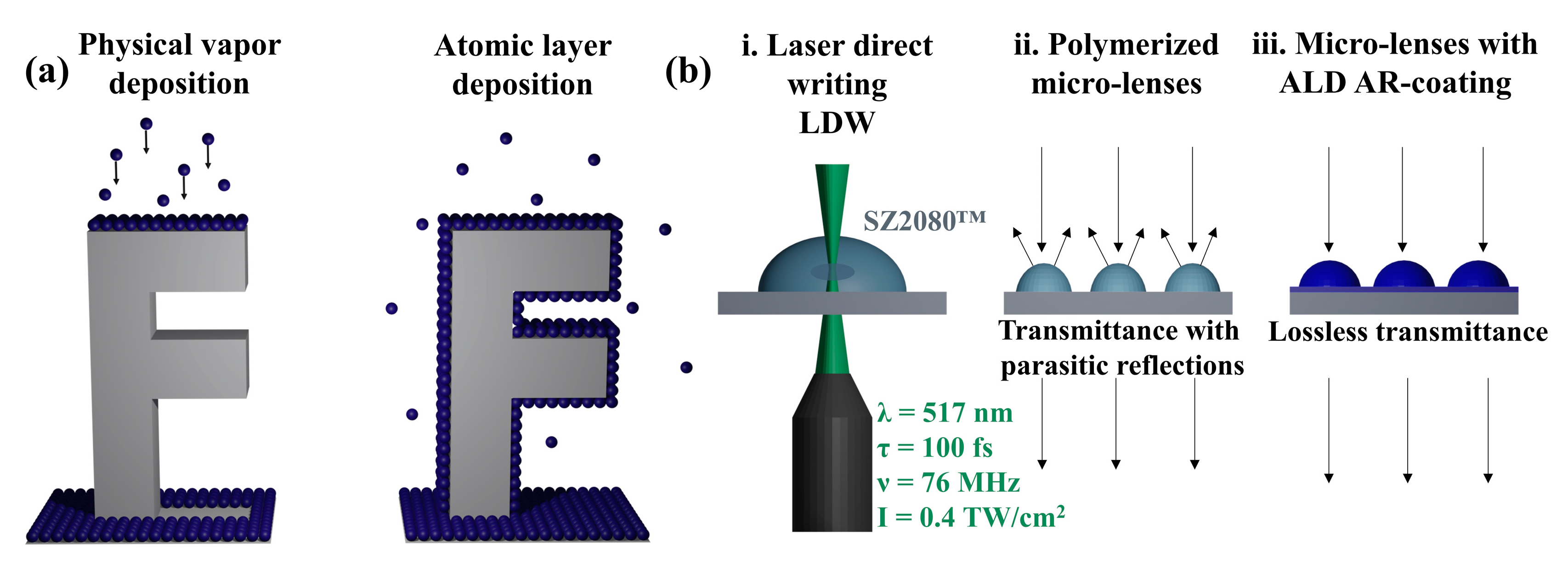


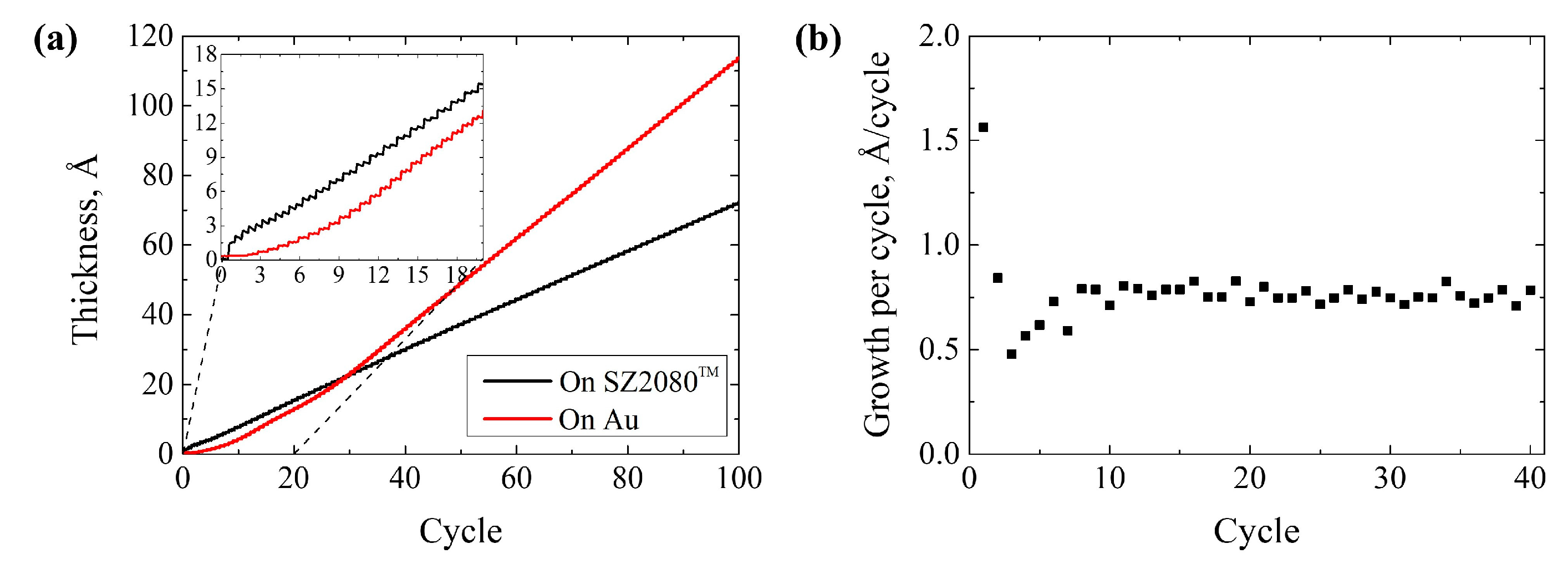
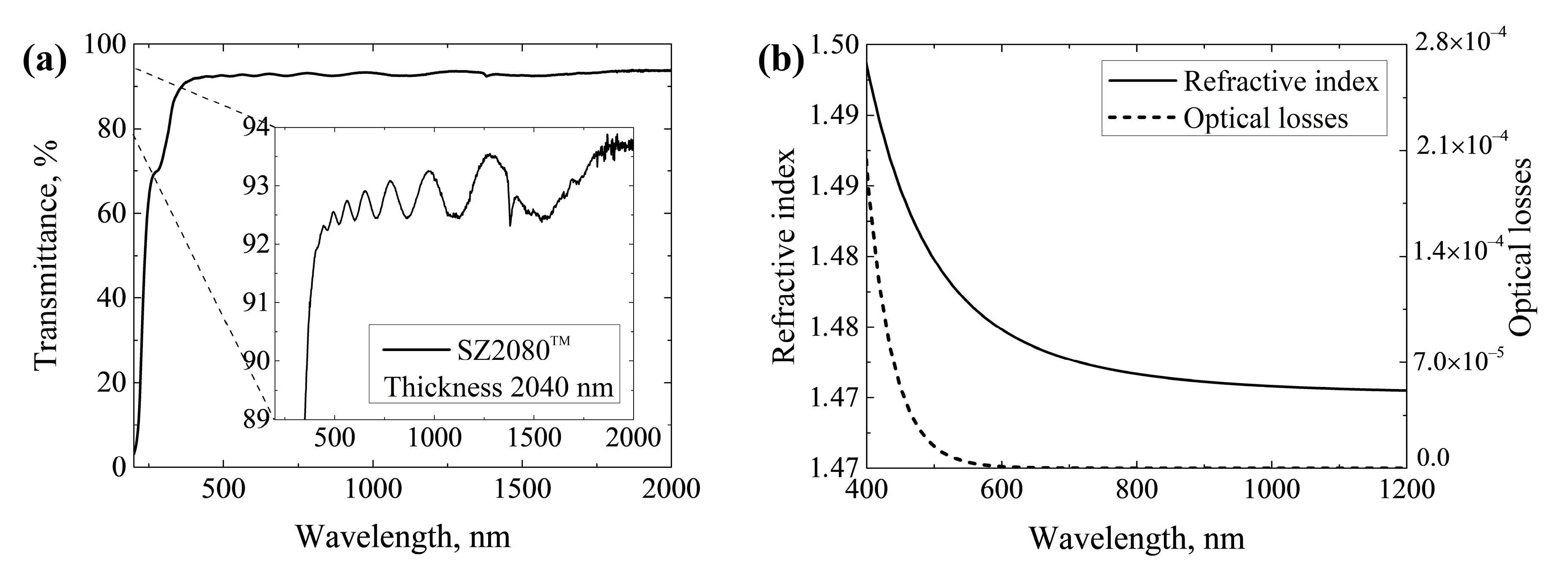

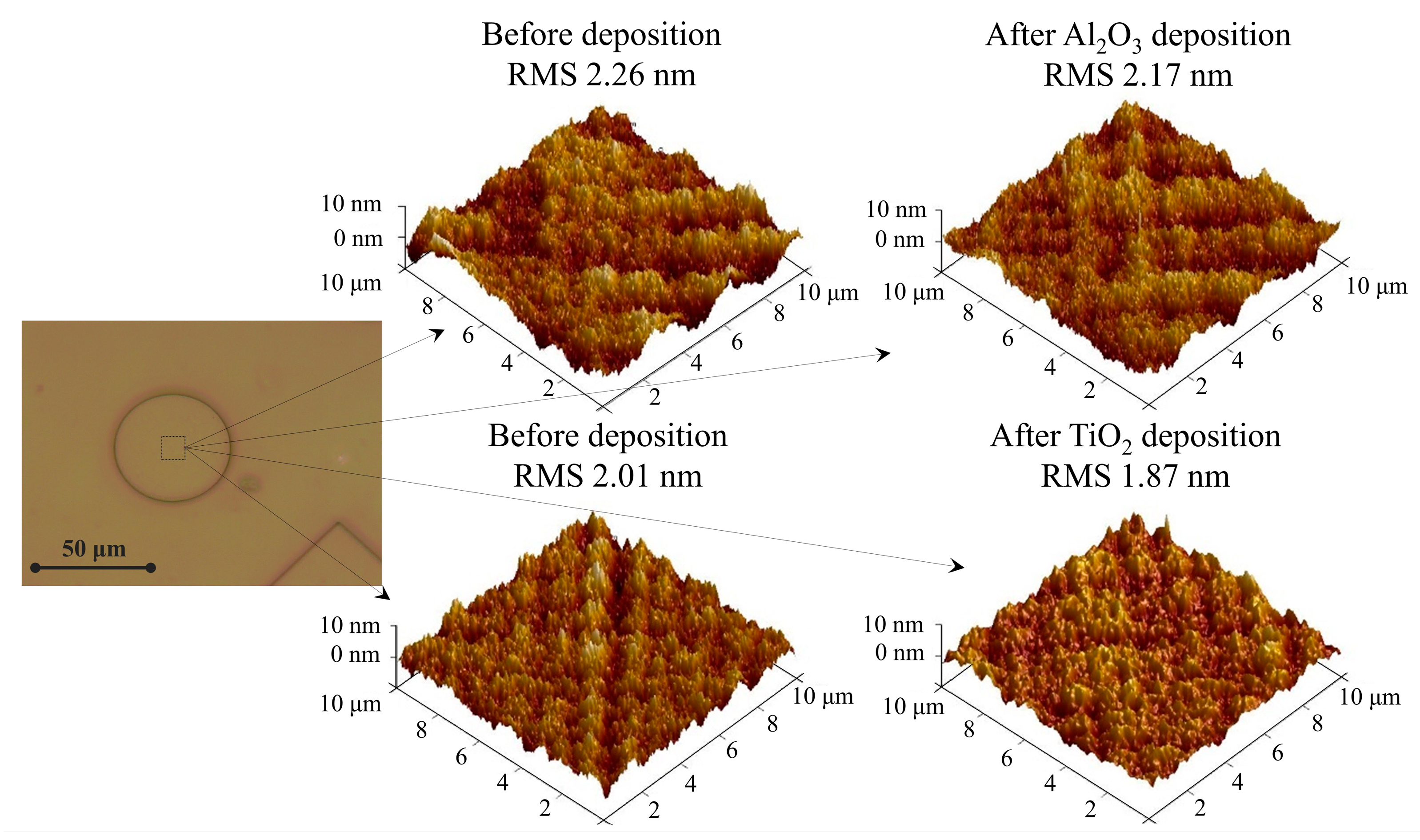

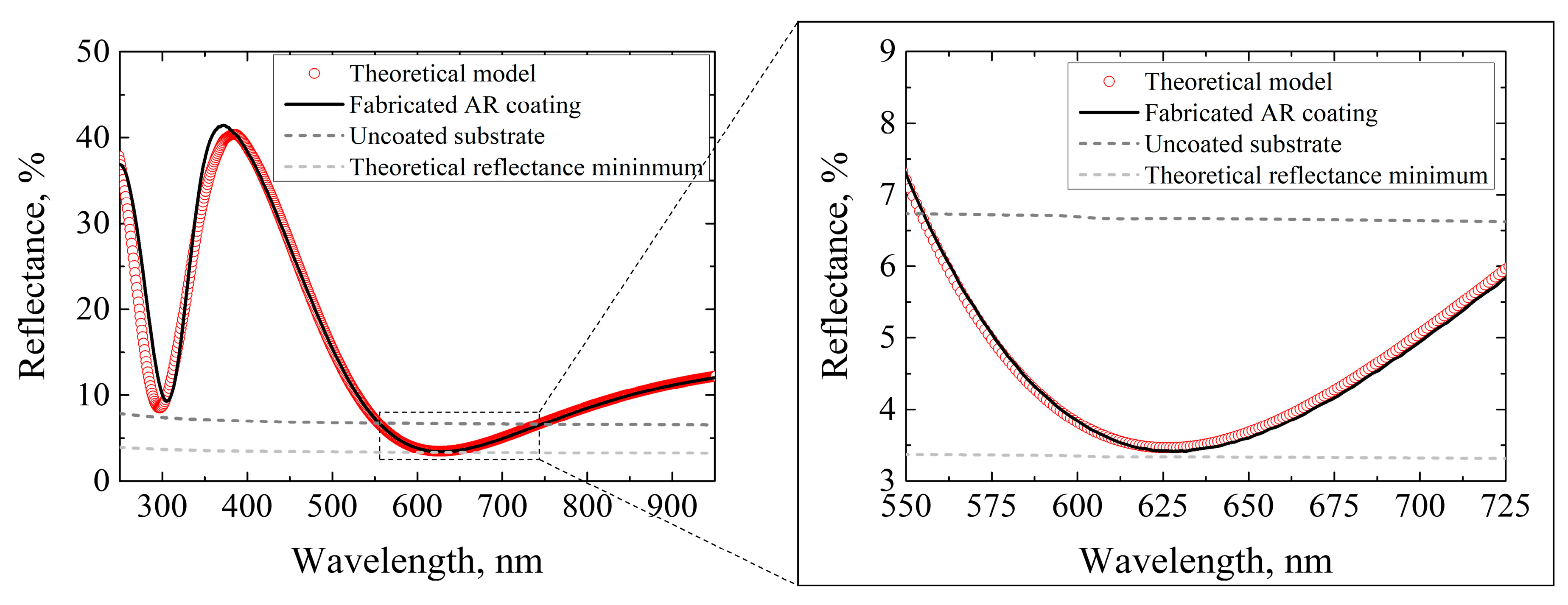
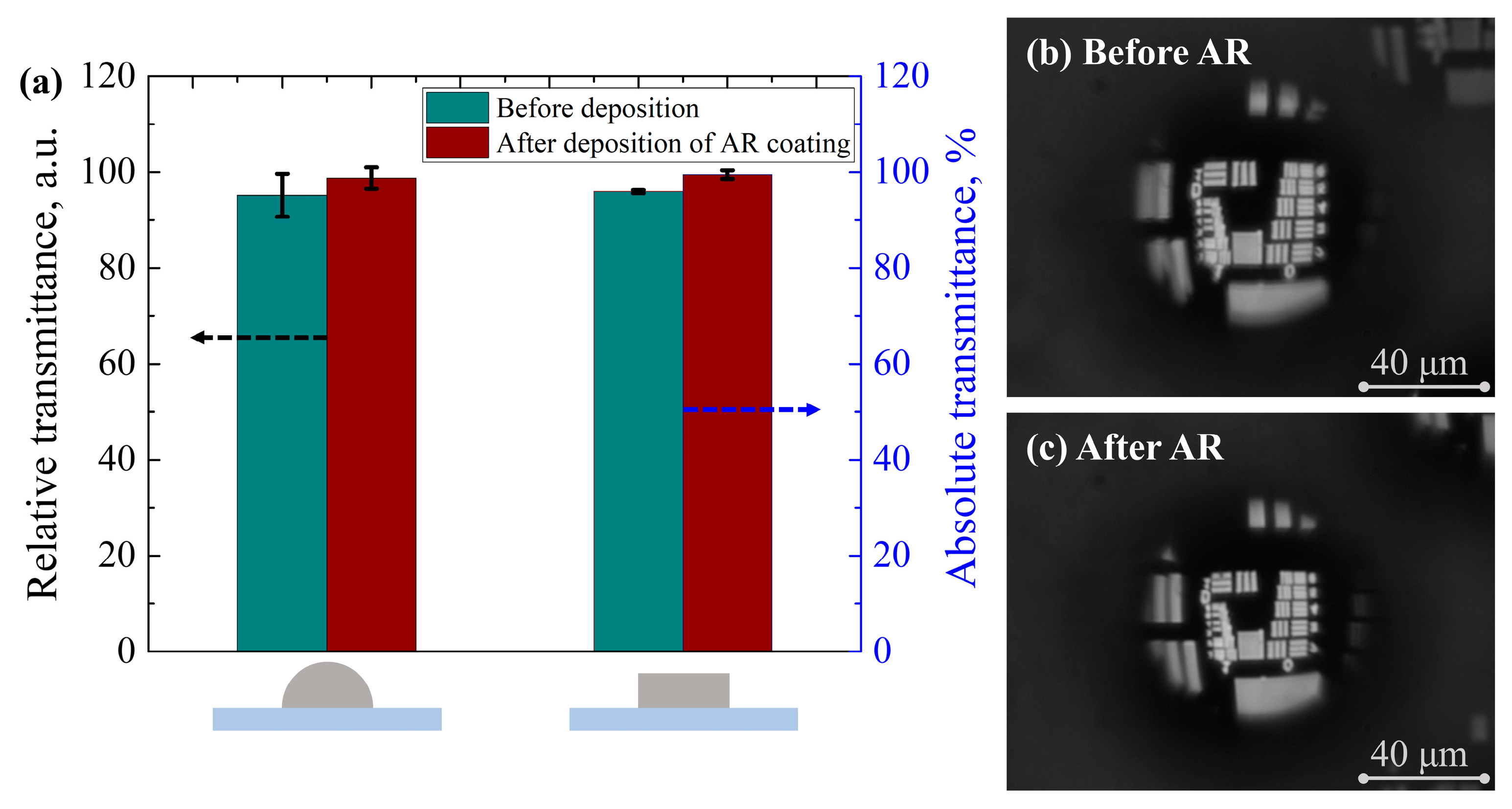

| Material | Precursor Pulse Duration, s | Purge Duration, s | O2 Plasma Pulse Duration, s | Purge Duration, s | Plasma Power, W |
|---|---|---|---|---|---|
| TiO2 | 0.15 | 15 | 6 | 15 | 200 |
| Al2O3 | 0.02 | 8 | 6 | 8 | 100 |
| Coating | Stress, MPa | Lens Diameter, μm | f0, μm | f, μm | Δf, % |
|---|---|---|---|---|---|
| Al2O3 | 135 | 50 | 187 ± 7 | 172 ± 2 | −8 ± 2 |
| 90 | 184 ± 6 | 170 ± 9 | −7.5 ± 3 | ||
| TiO2 | 86 | 45 | 142 ± 4 | 152 ± 5 | 7 ± 4 |
| 80 | 156 ± 3 | 159 ± 5 | 2 ± 1 |
| Coating | Stress, MPa | Lens Diameter, μm | f0, μm | f, μm | Δf, % |
|---|---|---|---|---|---|
| AR coating | 127 | 45 | 182 ± 7 | 185 ± 6 | 1.5 ± 0.8 |
| 95 | 190 ± 5 | 196 ± 5 | 3 ± 0.5 |
Disclaimer/Publisher’s Note: The statements, opinions and data contained in all publications are solely those of the individual author(s) and contributor(s) and not of MDPI and/or the editor(s). MDPI and/or the editor(s) disclaim responsibility for any injury to people or property resulting from any ideas, methods, instructions or products referred to in the content. |
© 2023 by the authors. Licensee MDPI, Basel, Switzerland. This article is an open access article distributed under the terms and conditions of the Creative Commons Attribution (CC BY) license (https://creativecommons.org/licenses/by/4.0/).
Share and Cite
Astrauskytė, D.; Galvanauskas, K.; Gailevičius, D.; Drazdys, M.; Malinauskas, M.; Grineviciute, L. Anti-Reflective Coatings Produced via Atomic Layer Deposition for Hybrid Polymer 3D Micro-Optics. Nanomaterials 2023, 13, 2281. https://doi.org/10.3390/nano13162281
Astrauskytė D, Galvanauskas K, Gailevičius D, Drazdys M, Malinauskas M, Grineviciute L. Anti-Reflective Coatings Produced via Atomic Layer Deposition for Hybrid Polymer 3D Micro-Optics. Nanomaterials. 2023; 13(16):2281. https://doi.org/10.3390/nano13162281
Chicago/Turabian StyleAstrauskytė, Darija, Karolis Galvanauskas, Darius Gailevičius, Mantas Drazdys, Mangirdas Malinauskas, and Lina Grineviciute. 2023. "Anti-Reflective Coatings Produced via Atomic Layer Deposition for Hybrid Polymer 3D Micro-Optics" Nanomaterials 13, no. 16: 2281. https://doi.org/10.3390/nano13162281





